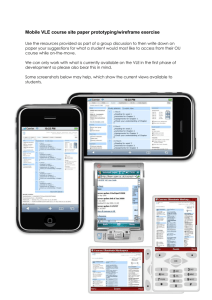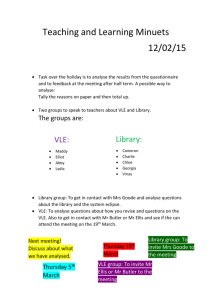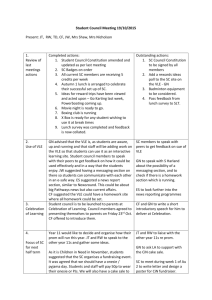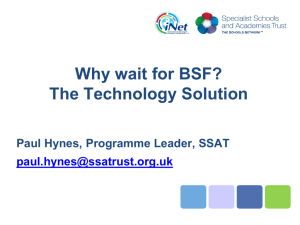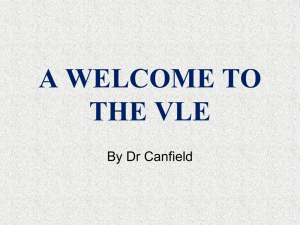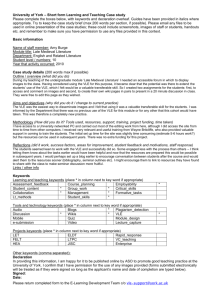Marina Orsini-Jones - Association of University Language Centres
advertisement
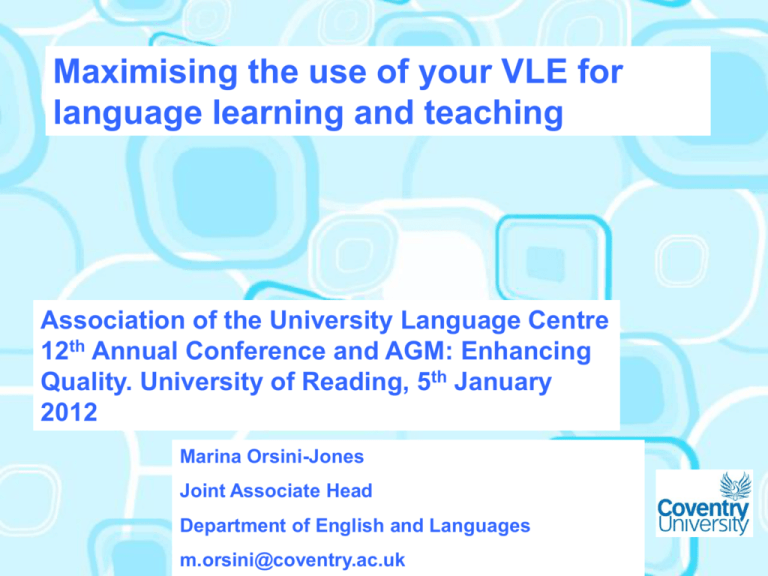
Maximising the use of your VLE for language learning and teaching Association of the University Language Centre 12th Annual Conference and AGM: Enhancing Quality. University of Reading, 5th January 2012 Marina Orsini-Jones Joint Associate Head Department of English and Languages m.orsini@coventry.ac.uk Virtual Learning Environments and Language Learning and Teaching: students can (from Web 1 to Web 2 and beyond) • Find more opportunities to plan their discourse • Reflect on their production • Compare their production with that of their peers and their teachers • Share language learning knowledge • Obtain immediate feedback on their learning • Acquire useful ICT transferable skills (myth of the “digital native”) • + connect to other learners globally/use their mobile phones – or other mobile devices - to connect to the VLE anywhere/anytime Virtual Learning Environments and Language Learning and Teaching: teachers can (from Web 1 to Web 2 and beyond) • Explore new ways of assessing students • Reflect on their students’ production • Research use-function-opportunities offered by the VLE with peers • Compare their students’ work with that of students in previous cohorts in an easier way • Maximise the opportunity for examples of good practice (displaying students’ output from one year to the other) • Obtain immediate feedback on their teaching if needed • Acquire useful ICT transferable skills • Detect web plagiarism easily (Turnitin) • + learn on the way their students interact with other learners and incorporate learners’ ‘tips’ on language learning into their teaching New horizons in CALL (becoming MALL): 4 skills anywhere/anytime + 5th skill (multilingual digital literacy) • Online speaking and listening : Skype, audioconferencing and discussions (synchronous and asynchronous) • Online virtual world creation: games, Second Life, World of Warcraft • Online knowledge sharing: Language learning exchanges (SNSs like Livemocha and Busuu) Engaging with new media: digital multilingual multiliteracies • ICT literacy • Employability • “Reading the world” Research evidence that effective use of elearning/blended learning can “empower the learner” Which VLE? overall principle - 1 An e-learning activity must be very carefully designed and is defined as a specific interaction of learner(s) with other(s) using specific tools and resources, orientated towards specific outcomes”. (Beetham 2007, 28, italics in original) overall principle - 2 As implied by McLuhan (1967) the medium (or media) chosen for the task affects the students’ learning experience and cognitive journey. overall principle - 3 Learning, as argued by Vigotsky, “is a socially mediated activity in the first instance, with concepts and skills being internalized only after they have been mastered in a collaborative context”. (Vigotsky 1986, cited in Beetham 2007, 36). overall principle - 4 Do not confine your children to your own learning for they were born in a different time. [ Hebrew proverb ] Adapted from Dudeney (2009), EuroCALL Plenary, “Beyond the Book”, used with permission overall principle - 5 Build metacognitive activities supported by elearning tools into your language learning tasks: thinking on how one learns is proven to help with learning (and it fosters employability skills too) and link them to assessment Tip 1: Personalise the environment e.g.: Blackboard and Wimba Voice tools embedded in Vista 4 Tip 1: Personalise the environment e.g.: Moodle and Nanogong Free and open source audio applets (IMS and SCORM) Free conferencing – Big Blue Button (OR Wimba collaborate) Tip 2: Organise your material by maximising the tools How? within your VLE (and using a digital repository) Tip 3: Ask your students for suggestions on what to How? include Tip 3: Ask your students for suggestions on what to How? include: e.g. BECTA extensive tutorials nln http://go.nln.ac.uk/content/tata4_FK12_Future%20tense%20using%20Goin g%20To/harness/frameset.htm Tip 4: don’t reinvent the wheel Useful packages exist already (e.g. EAP toolkit and Clarity materials for EAP/EFL respectively) Useful websites too There is not much point in spending time re-creating ‘drill and kill’ behaviouristictype tests when they are available for free on the web and are proven by research not to improve LL but include some in your course, they keep the students happy… Tip 5: be creative Allow for effective interface of the VLE with the ‘world outside’, e.g. options with hypertext creation: examples of textreconfiguration – exposing students to different e-genres of Italian texts (Elena Polisca – University of Manchester) Tasks aimed at fostering learners’ autonomy and multiliteracy awareness Good practice from Manchester: CAMILLE 1 – Hypertext (Elena Polisca) CAMILLE 2 Streamed MP3 tracks embedded video from Youtube Core text contains auto-generated glossary terms linking to Media Library CAMILLE 3 CAMILLE 4 Included images, audio and video in some question types (using HTML) Options with hypertext creation: examples of text-reconfiguration 2 (MOJ/CU 1998-2008) Group task of ‘deconstructing text’ following guidelines on translation contained T in Ulrich (1992) u online with links to online dictionaries and t corpora/concordancers o Analysed texts ‘taught’ to peers inr assessed ‘microteaching’ translation sessions Evidence from relevant literature (e.g. Klapper 2006) that adult learners learn languages better via project work carried out over a number of weeks Cycles of action research to evaluate impact of tasks on students’ learning experience (qual and quant data) Student group translation (constructivist task shared via the VLE and discussed f2f and online) – Language and Literature (CU) also suitable for history of art courses run by LCs Tip 6: explore your VLE and make creative use of other platforms that can be launched from within it, e.g. eportfolios like PebblePad and Mahara • The LC at Warwick is piloting an interesting assessment model with Mahara • The Common European Framework can be used in conjunction with an e-portfolio Assessed ‘Group grammar analysis’ – Built with the webfolio tool in the e-portfolio PebblePad and shared via a ‘gateway’ – French example (CU) Metacognition – reflecting on how grammar is learnt on blogs in PebblePad (CU) Positive feedback T Analysing a text in this way highlighted to us u linguistic aspects that we had nott noticed on o the paper version of the text r Tip 7: bear in mind accessibility issues No-nos: animations/non accessible fonts/illegible colours (e.g. red/yellow;black and blue)…. Your tips? Emerging new ‘hybrid’ environments for language learning: the personalised classroom online - Social Networking Sites to learn languages (also available as phone apps) ’disruptive technologies’ in that they allow for new and different ways of doing familiar tasks. Godwin-Jones (2005) (quoted in Brick 2010) Tandem learning in ‘controlled conditions’: MentorIT Manchester (Elena Polisca) VLE-based tandem learning secondary schools/unis BB Language Learning SNS Functionality (Brick 2010) • Web-based – no downloads. • Synchronous voice and asynchronous text chat • Learning materials • Peer review of written and spoken submissions • Profile matching (languages, levels) • Motivational tools Pandora’s box of multilingual BB multiliteracies? Ultimate user-centred model of LL? Finally: apps/open VLE models • Twitter feeds? • Facebook? • SNSs? Difficult to handle assessment via non proprietary platforms, ethical issues, but…possible and happening The FREEE – Fluid Role Evolving E-learning Environment (© Orsini-Jones 2009, in Orsini-Jones 2010: 357) Affordances of multifunctional personalisation of the e-learning zones inhabited by students in a connected ‘global village’ References can be emailed on demand Based on two forthcoming chapters • Orsini-Jones, M. (2010) Shared spaces and ‘secret gardens’: the troublesome journey from undergraduate students to undergraduate scholars via PebblePad In J. O’Donoghue (Ed.) Technology Supported Environment for Personalised Learning: Methods and Case Studies Hershey, PA: IGI Global. (pp. TBC). • Orsini-Jones, M. (2010) Task-Based Development of Languages Students’ Critical Digital Multiliteracies and Cybergenre Awareness. In M.J. Luzon, N. Ruiz and L. Villanueva (Eds.) Genre Theory and New Literacies. Applications to Autonomous Language Learning. Cambridge: Scholar. Any questions? • m.orsini@coventry.ac.uk
